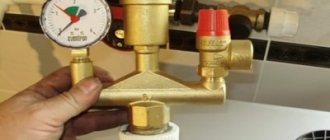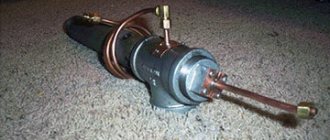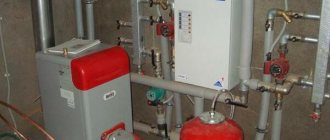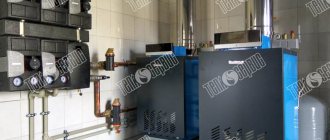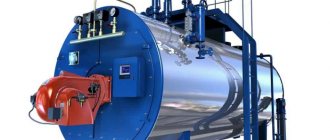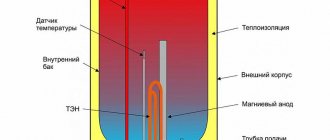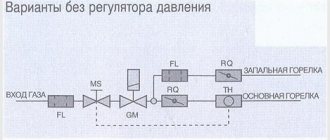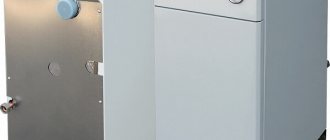Home / Boiler rooms
Back
Published: November 30, 2019
Reading time: 2 min
0
769
Although infrequently, news about exploding boilers still appears in emergency reports from time to time. And what’s most interesting is that the reason is not always a faulty stove or an unextinguished cigarette.
It also happens that the heating boiler becomes the culprit. We are accustomed to the fact that all devices whose names contain the word “industrial” are used in manufacturing enterprises, on the territory of factory workshops and large workshops.
In fact, this is not always the case. Companies involved in the production of heating equipment offer consumers large installations for autonomous heating of apartment buildings.
Consequences of a boiler rupture
And although they are used in residential buildings, they are still called industrial. The reason is the high power, which is quite enough not only for a multi-story building, but also for a warehouse and a large production line.
But they also tend to fail. The only problem is that the consequences can be dire.
- 1 How does an industrial boiler explode?
- 2 Safety precautions
Why do household boilers explode and how to operate them safely?
The mechanism of boiler explosion is simple. The risk zone mainly includes those boilers that do not operate constantly, but sporadically. Weak spots are where the heating system can be “caught” by ice - these are expansion tanks, circulation pipes and cold rooms such as attics.
The main reason why boilers explode is the heating system freezes, and the water in the pipes stops circulating. The fuel continues to burn. Water boils inside the cast iron (metal) sections of the boiler or pipes. At the same time, the vapor pressure inside the system begins to increase very quickly. At some point, a critical point of pressure growth will be reached, which the metal cannot withstand - and it is no longer possible to predict what the consequences of the destruction of pipes and sections of the boiler will be. The fact is that at the same time a very large volume of steam-water mixture is thrown into a confined space. The pressure inside the room is rising rapidly. And, at best, it will all end in broken glass. In the worst case scenario, the structure of the room will be destroyed, harm to human health or even death of persons in the area of the explosion may occur as a result of the collapse of the structure of the boiler room.
For example, on January 4, 2016, there was an explosion of a domestic solid fuel boiler installed in an apartment of a blocked residential building in the city of Lyakhovichi. No one was injured; the enclosing structures of the furnace room in which the boiler was installed were damaged. The cause of the explosion was a lack of water circulation in the heating system, presumably as a result of an ice plug in the outlet pipe. Contributing factors are an unsystematic mode of boiler firing, forced operation of the boiler by a person who does not know the rules for safe operation of the boiler.
On January 8, 2021, in Lyuban (Minsk region), a household solid fuel boiler exploded in the boiler room of a residential building. As a result of the explosion, a brick wall collapsed, the roof was damaged, and the boiler room and boiler were destroyed. There were no casualties. The cause of the explosion is being established.
Over the past eight years, this is the seventieth emergency that has occurred during the operation of domestic heating boilers.
To reduce the risk of freezing of boiler and heating system pipelines, Safety Rules require owners of potentially dangerous objects, i.e. hot water boilers, so that the installation and commissioning of heating systems is carried out only by specialized organizations registered on the territory of the Republic of Belarus and having the appropriate permission (license) from Gospromnadzor to perform this type of work.
In this case, employees or specialists of this organization must train the owner in the rules of safe operation of the boiler and heating system and make a note about this in the boiler passport.
Before starting the boiler, the homeowner must make sure that the shut-off systems must be open on two pipelines at once - the one that supplies coolant to the boiler, and the one that removes coolant from the boiler. It is also necessary to open all shut-off devices installed on the heating system. Accumulated condensate must be removed from the lower section of the chimney. This will help avoid carbon monoxide poisoning. It is necessary to regularly check the condition of the chimney head and chimney channels. Before starting to ignite the boiler, it is necessary to open the system make-up line and the control line for filling the expansion tank. The fact that the system has not frozen will become clear when water begins to flow out of the control line.
But let’s imagine the following situation: no water came from the control line of the heating system. What to do in this case? If the pressure in the boiler continuously increases and reaches the pressure of the water supply network, this indicates that the heating system is frozen. In this situation, lighting the boiler is strictly prohibited. There is no need to hope that the steam will overcome the ice plug - along with this, the steam will destroy both the pipeline and the boiler. It is necessary to determine the approximate place where the heating system freezes, warm it up and check whether water flows from the control lines of the heating system when the make-up is open. And only if this happens, start lighting the boiler, while monitoring the pressure gauge readings. If the coolant pressure in the heating system approaches the maximum permissible, you must immediately stop the fuel supply. If the boiler runs on local fuels, you need to remove it from the boiler to a safe place. This state of the heating system indicates that the heating system is not heated.
It doesn’t happen often, but it also happens that a boiler installed there freezes in the attic. Like a pipe, heating it with an open fire is strictly prohibited; this can be done using, for example, hot water. However, if during heating you see water coming from the heating surface of the boiler, this means that the boiler has become depressurized. And he has only one way - to the repair shop. In this condition, the boiler is unsuitable for further operation. Specialists who have the appropriate permission to do this will digest a steel boiler, but in a cast iron boiler they will replace the damaged sections and repack them.
The Gospromnadzor authorities are particularly concerned about the operation of boilers created (welded) by the so-called “Kulibins” (traditional craftsmen).
In the past five years, eight boilers that have exploded were homemade. Craftsmen somehow riveted heating units together. But it is clear that in this case there is a huge risk that problems may begin with heating surfaces, fireboxes, stagnant zones of boilers... In the end, this ends with the water overheating, which leads to a rupture of the boiler. In addition, it must be taken into account that, as a rule, “homemade products” are not equipped with thermometers, pressure gauges, or safety valves.
And therefore Gospromnadzor warns: do not use homemade boilers and do not trust the installation of certified heating units to persons who do not have special qualifications. The money you save on this may come back to haunt you with fire, severe destruction or serious injury to people. So is it necessary to risk your property, housing, and maybe your health or even your life in order to save material resources?
Chief State Inspector V.V. Pavlyushchenko
Leading State Inspector
Misyun V.M., Kazimirsky O.S.
Author: Intex-press
On the causes of explosions in soda recovery boiler units (SRB) and measures to prevent them
At pulp and paper mills, in modern sulfate-pulp production, the soda recovery boiler unit (SRB) is one of the main components of the equipment. It burns waste liquor, resulting in the regeneration of chemicals used in the future for pulping, and at the same time generating steam for energy parameters. Being an energy-technological unit, the SRK consists of its own boiler and a set of auxiliary technological equipment included in the schemes for preparing liquor for combustion, cleaning flue gases and process emissions. Using the potential heat of waste liquor makes it possible to cover a significant portion of the production energy consumption balance.
The specificity of the SRC is that the spent black liquor burned in the furnace is, from an energy point of view, a wet, high-ash and low-calorie fuel, as well as the accumulation of a significant amount of molten sodium salts on the bottom of the combustion chamber at a temperature of about 850-900 °C [1].
Previously, at the vast majority of pulp and paper mills, SSCs were used at operating parameters: pressure up to 4.0 MPa (40 kgf/cm2) and superheated steam temperature up to 440 °C. This was caused by the need to prevent high-temperature corrosion of heating surface pipes. At the moment, in accordance with federal standards [2], the use of SRC at higher parameters is permitted provided that special measures are taken to prevent high-temperature corrosion of heating surfaces.
Taking into account the high specific potential danger that soda recovery boiler units pose, they, in accordance with the above Standards, must be installed in separate buildings, and the control panel must be installed in a room separate from the boiler shop, having an exit in addition to the room for the SRC.
It is permitted to arrange the SRK in one common block with power, water-heating and recovery boilers, as well as those inextricably linked with evaporation and oxidation units of liquors.
The reliability assurance program for the production of soda recovery boilers has three stages: design, development of manufacturing technology, and manufacturing process. The implementation of the stages leads to the creation of initial properties that can be characterized as potentially possible. At different periods of operation, actual properties are compared with potentially possible ones and reliability is assessed based on the degree of change.
The main indicators of reliability are reliability, durability, maintainability, and storage. Reliability is ensured at the stages of design, manufacturing, operation and repairs. Mistakes made at any of them nullify material resources, labor costs and time spent at all other stages. The perfect design of a control valve with high technical and economic indicators, large-scale automation, ensuring comfortable working conditions, cannot be implemented if pipes, tees, fittings, rolled metal and other materials and equipment of poor quality were used for its manufacture, and the technological process was carried out with violations requirements of regulatory technological documentation. Boilers with high potential reliability can quickly become completely unusable if the operating modes specified by the design are not observed, and operation is carried out by insufficiently qualified personnel [3].
Therefore, increased requirements must be placed on operating personnel in terms of knowledge of the basic principles of organizing the combustion process and the physical and chemical properties of liquid sulfate melt, because under certain conditions, the interaction of melt with water can lead to explosions. In addition, the SRK uses high-calorie auxiliary fuel (gas, fuel oil), which is used when starting and stopping the SRK, during interruptions in the supply of black liquor from the evaporation station, and for “lighting” in the event of an increase in the moisture content of the liquor above the stable combustion limit. This imposes additional conditions on the organization of operation of the boilers in question since Failure to comply with the rules for burning fuel oil or gas can cause explosions in furnaces. The possibility of explosions in the solvent tank at the moment of contact of the melt with green liquor cannot be ruled out. Such explosions can cause serious damage to equipment. In the domestic industry, there have been several cases of explosions of varying strength in the SRK. The duration of emergency repairs ranged from several days to several months. It must be remembered that an explosion of flammable gases in the firebox of the SRK can lead to damage to the pipe system and the entry of water onto the float, which will further aggravate the accident.
From the publication (p. 164) [4] it follows that in 1964 and early 1965, Ahlström-Varkaus, a.s. Svenska Maschinen Werke, Mitsubishi, Sanchi, Parsons and others sent information letters to the Soviet Union about the explosion hazard of soda recovery boilers. From these reports, as well as from published materials, it became known that at that time a number of explosions occurred abroad during the operation of soda recovery boilers.
For example, in the USA, out of 223 soda recovery boilers, 38 exploded; In Canada, 33 explosions occurred at 76 enterprises with 174 soda recovery boilers. The explosions led to extremely serious consequences. It was found that approximately 40% of accidents occurred due to the explosion of an explosive mixture of gases accumulated in the furnace from unburned auxiliary fuel, 40% of explosions occurred as a result of water entering the cinder and into the melt when the boiler screen pipes ruptured, and 20% due to gross violations of basic technical operation rules .
At the moment, we do not have statistical data for the period 1964-1965, but the individual archival materials at our disposal allow us to assert that in domestic operational practice, explosions of SRK of varying strength were not a rare occurrence. Thus, in 1966 [4] at one of the enterprises, during the shutdown of the soda recovery boiler unit, a large amount of unburned cinder was left on the furnace floor. During the startup of the boiler, after connecting it to the steam line, it was discovered that the only tap hole of the firebox was clogged with frozen melt and cinder.
Since it was not possible to break through the melt tap hole for a long time, the operators turned on one lye nozzle with increased fuel oil combustion to increase the temperature in the furnace in order to melt the melt solidifying in the tap hole. After some time, the melt accumulated in the firebox gushed through the leaks in the hearth. The maintenance personnel, having turned off the oil burners and the fan and disconnected the boiler from the steam line for the purpose of cooling, began to generously pour lye over the mass of hot melt. A few minutes after this, an explosion occurred, as a result of which the pipes of the screens, the beams holding them together, the frames bent, and the lining of the boiler was destroyed.
An analysis of the operation of soda recovery boilers [5], carried out on the basis of the results of surveys by commissions and the departmental technical supervision service, shows that despite a number of instructions from the Ministry of Pulp, Paper and Woodworking Industry of the USSR, at many enterprises in the industry, the work of the control system was carried out with deviations from the Rules and Standards, at a low technical level, which led to emergency situations. Thus, on November 11, 1981, the SRK-350 was emergency stopped at the Baikal Pulp and Paper Mill. Consideration of the circumstances preceding the emergency shutdown shows that the boiler operated for two hours in the absence of voltage on the control panel, without operational control by operating personnel, resulting in water loss, circulation disruption, overheating of the heating surface pipes and subsequent rupture of one of them at +9.3m. right rear block. On November 26, 1981, at the Bratsk LPK production association, an explosion occurred in the furnace of the SRK. An investigation into the causes of this accident showed that after reconstruction with the replacement of the lower part of the furnace, the boiler was put into operation with the protections, interlocks and alarms disabled. Due to incorrect readings from level sensors, the boiler operated without feedwater supply, which led to water loss and circulation disruption. The operating personnel did not take measures to stop the operation of the boiler, but turned on the fuel oil nozzles, which caused overheating of the screen pipes and rupture of one of them. Instead of completely stopping the boiler feed, the personnel switched the feed valve control to manual control and fed the boiler after the screen pipe ruptured for 30-40 minutes. As a result, two hours after the boiler was stopped, an explosion occurred in the furnace, the combustion chamber became deformed, which led to the need to carry out restoration work over a long period of time.
At the Segezha Pulp and Paper Mill on February 18, 1982, an explosion occurred in the SRK-700 furnace, as a result of which the front screen was torn from the side screens from an elevation of +14.4 m to the top of the furnace (an elevation of +31.5 m). The remaining screens were deformed. The accident occurred as a result of incorrect actions of personnel to eliminate a melt leak in addition to the tap hole. Instead of stopping the boiler, as provided for in the “Accident Elimination Plan” developed at TPP-2, the personnel, by removing the lye nozzle from the pumping device and turning it around, poured lye into the area of the supposed melt leak for 20 minutes. As a result of gasification of the lye poured onto the firebox, an explosive mixture of gases was formed, and it exploded. An analysis of the operational documentation showed that in the protection, interlocking and signaling scheme there were deviations from the requirements of the current rules and regulations, and the operating instructions for the SRC had not been revised since 1972 and had significant errors.
Emergency shutdowns of the control system associated with the inoperability of automatic control systems, instrumentation, interlocks and protections occurred at a number of other enterprises in the industry.
At the thermal power plant of the Astrakhan pulp and paper plant [6] on November 24, 1984, an explosion occurred in the combustion chamber of SRK-560 station No. 2. Immediately before the explosion, due to the lack of liquors, the SRK was transferred to burning fuel oil. During the same shift, the fuel oil facility of the plant was draining fuel oil from railway tanks. Due to the lack of a receiving tank, fuel oil was received directly into supply tanks, from which fuel oil was supplied to the boiler room.
At 14:40, the shift manager of the thermal power plant and the maintenance staff of the boiler room, in order to reduce the load of the BKZ-75-39 GM station’s boilers, discovered that water was getting into the fuel oil pipelines of the boilers. The pressure in the drums of the BKZ-75-39 boilers decreased to 25 ati, and the SRK st. No. 1, which ran on fuel oil, went out. The shift manager of the thermal power plant warned the personnel servicing the station's control system. No. 2 about water getting into the fuel oil pipelines, gave an order to stop draining fuel oil from the remaining tanks and to open a fuel oil recycling line at the SRK station. No. 2 in order to increase its consumption. At 2 p.m. 45 minutes later there was an explosion in the furnace of the SRK station. No. 2, as a result of which the firebox screens became deformed, the front corners of the firebox were opened up to 145 mm, the corner joints of the stiffening belts were broken, the 10 rear pipes of the boiler bundle were deformed, and the insulation and plating were damaged.
The cause of the accident was the ingress of water into the fuel oil pipelines and fuel oil nozzles and the incorrect actions of the operating personnel, who knew about the ingress of water into the oil pipelines, but did not take measures to emergency stop the SRK.
On 12/04/1984, at TPP-3 of the Bratsky LPK Production Association, an accident occurred with the soda recovery boiler SRK st. No. 12. As a result of the explosion in the boiler furnace, it opened along its entire height in all four corners with the formation of fistulas in the screen pipes and the superheater. In this case, the walls of the combustion chamber, the belts and the stiffening beams were deformed. The maximum deflection at the height of the fifth stiffening belt is 210 mm. The investigation showed that the accident occurred as a result of a gross violation by the operating personnel and officials of the “Production Instructions for the Safe Operation of the SRC” when eliminating a melt leak in the left corner of the firebox. Instead of supplying compressed air or stopping the boiler, as provided for in the Instructions, it was decided to eliminate the melt leak by supplying black liquor to the damaged area by turning the liquor nozzle. With the fuel oil nozzles turned off and in the absence of cinder on the hearth, gasification of the liquor occurred, the formation of an explosive mixture of gases and an explosion in the boiler furnace. The investigation also found that violation by operating personnel of the Rules and Instructions for the operation of the control system at TPP-2 and 3 of the Bratsk Forestry Plant became a system. Thus, a similar accident at SRK-12 with less serious consequences occurred on March 7, 1984. However, even after that, the station continued to violate the Instructions for eliminating fluid leaks (12/01/84 and 12/02/84).
The accidents that occurred testified to the lack of systematic systematic work with operating personnel, the lack of control on the part of the management of the thermal power plant over the actions of personnel in the performance of production duties, and the formal conduct of emergency training.
From international experience it follows that the Soda Recovery Boiler Advisory Commission (BLRBAC), specially created at one time, developed a recommended system aimed at preventing or reducing the consequences of explosions when water enters the melt. This system is known as the Emergency Stop Procedure (ESP). If it is clear or suspected that water is entering the BLRB furnace, the operator is obliged to activate the ESP procedure, which simultaneously sends a signal about the emergency evacuation of people and, according to the program specified by the SRB manufacturer, carries out an emergency stop of the boiler.
The Consultation Panel, for summarizing and analyzing the causes, has materials on cases of SBS explosions at North American plants, as a result of which it took several days to restore boilers, and in the worst cases the damage was so great that restoration took several months. It was noted that the main sources of water entering the SRC furnace were leaks through the pressure components of the boiler. In addition to semi-annual or annual boiler fireside inspections, the Commission recommended annual inspections of the boiler heads to detect existing leaks and identify potential leaks to take proactive steps to prevent water contact with the melt. During the annual inspection, it was also recommended to check: the ESP system, low water level protection, black liquor system and auxiliary combustion system. Particular attention was paid to the need for periodic monitoring of the level of training of operators to determine that they not only have knowledge of the operation of the water dispenser in normal mode, but are also able to recognize various emergency situations, know what corrective actions are appropriate, and are able to determine when water is entering into the firebox, and how the ESP system is activated.
In addition to water entering the firebox when heating surfaces are destroyed (fistulas, ruptures), there are several other sources of water. If the water content of black liquor exceeds 42%, it may cause an explosion. Condensation may enter through a faulty soot blower system or a faulty steam coil heater. Water may come from external flush water hoses, a water flush system for black liquor lines, or faulty liquor heat exchangers.
In order to prevent high-temperature corrosion of heating surfaces, when using soda recovery boilers at operating parameters of more than 4.0 MPa and superheated steam temperatures of more than 440 ° C, composite pipes, chrome plating of pipes, spray metallization and welding of stainless steel coatings are widely used. Composite materials are a fundamentally new class of structural materials, without which progress in power engineering would be impossible. When surfacing a stainless coating, including during repairs, if necessary, you should take into account the recommendations of Chapter 12 [7] and you must remember that during installation, repair, reconstruction (modernization) of these boiler units, the use of steel pipes that were previously in consumption.
A study of the technical documentation of manufacturing enterprises for foreign soda recovery boilers supplied to Russia indicates that manufacturers very carefully and quite specifically regulate the frequency, scope and methods of monitoring and flaw detection of components and elements of the SRC during their operation, while defining requirements for the qualifications of personnel, who can perform this, the requirements for instruments and control equipment, as well as the quality of the instruments used.
Our specialists were convinced of this when carrying out metal control work during the annual capital shutdown of a soda recovery boiler with a capacity of 3560 t.w./day, the design parameters of the steam in the drum were 12.4 MPa (124 kgf/cm2), the temperature of the superheated steam was 490± 50 °C.
The boiler was manufactured by ″Andritz Oy″ Satakunnaankatu 7, Varkaus, Finland in 2009, installed at the OJSC Mondi Syktyvkar LPK enterprise, installed in a separate building, and the control panel in a room separate from the boiler shop, which has an exit in addition to the room for the control system.
The appendix to the technical specifications, approved by the Technical Director of OJSC Mondi SYLPK, indicated: a matrix for delineating responsibilities, the scope of metal inspection, the range of pipes used and their permissible thickness, instructions for inspections during the annual shutdown (Andritz).
This article is not discussed, but during the operation of the SRC, it is extremely important to ensure operation without damage to the heating surfaces and other elements of soda recovery boiler units if the requirements of the SRC manufacturers for organizing the water chemistry regime and proper control over its implementation are fulfilled.
Return to blog
What is backfire in a pellet heating unit?
The term “backfire” in the field of pellet heat-generating devices means the advancement of the fire front from the normal combustion zone in the boiler (in the pellet burner cup or on the fittings of the combustion unit) towards the pellet storage (pellet bunker).
The phenomenon is quite unpleasant, leading to failure of the pellet supply system (the auger can collapse under the influence of high temperatures), and in the most critical case, to a fire.
As we know, for the correct operation of a pellet burner, two substances are needed - oxygen (air) and pellets. They are forced into the combustion zone: air is pumped by a fan, and pellets are fed using a screw. Part of the air is supplied through special air ducts directly into the combustion zone in the form of primary or secondary air, and part is supplied through the same channel (auger) through which pellets are supplied.
The proportion of these parts of the air supply must correspond to a certain formula, because on the one hand, the complete absence of air movement in the pellet supply channel can itself provoke a backfire, and in the case of 100% air supply through the pellet channel, we must ensure the tightness of the bunker, otherwise When resistance arises in the burner cup, part of the air will escape in the pellet hopper, blowing out wood dust.
In a situation where the supply of one of the required components is stopped or obstructed, conditions arise for a backfire to occur.
| photo 1. The feed auger and reed valve (above) are synchronized. An optical intermediate chamber filling sensor is shown. |
When the pellet supply is stopped, the pellets in the burner cup first burn out (normal operation), and then the smoldering flame begins to move towards the pellet storage bin. This process can be almost imperceptible from the outside, and the supply of air at this point can aggravate this process. By the way, this is precisely why it is so important to shut down a pellet boiler correctly. The stopping algorithm varies from manufacturer to manufacturer, but the main thing is to feed the remaining part of the pellets in the auger into the burner and burn them using forced air supply.
When the air supply is stopped, the boiler is most likely to stop, since pellets without air supply burn with worse characteristics. In this situation, it is possible that unburnt pellets may be poured into the ash bin, which is also not the norm. However, if the boiler continues to operate, due to the lack of air supply to the combustion zone, smoldering may move towards the bunker despite the supply of pellets. I would especially like to note the need to control the tightness of all air duct connections; the fact is that if a hole in the outer part can only lead to a loss of power, then the outgoing air in the combustion zone can even burn through the cast iron parts of the boiler.
How to prevent backfire
As mentioned above, the cause of backfire is the operation of the boiler in emergency mode (stopping the supply of one of the components necessary for combustion, emergency shutdown of the boiler) or incorrect settings of the boiler, for example, if the pellet supply speed (and, accordingly, their volume) does not match. the volume of supplied air, pellets can first burn out in the burner cup, and then continue burning in the auger itself. The main way to prevent this unpleasant phenomenon is to properly configure the boiler, prevent its emergency operation, and use boilers with intelligent control units. Therefore, by the way, we recommend installing intelligent uninterruptible power supplies, with the help of which it is possible to correctly shut down the boiler.
How to fight fire
Anti-backfire systems can be divided into active and passive systems. Active systems are aimed at eliminating the causes of backfire and returning the boiler to normal operation, while passive systems are aimed at extinguishing it and stopping further progress towards the pellet bunker. Modern pellet boilers use mixed active-passive systems.
Active systems A temperature sensor is built into the pellet feed screw of the BioLine burner. As the flame spreads, the temperature rises and when the threshold value is exceeded, the sensor activates the electric motor of the internal auger, while simultaneously blocking the operation of the external auger. All this leads to a break in the flow of pellets as a medium that transmits fire. In addition to breaking the medium, the internal auger moves smoldering pellets into the normal combustion zone, freeing the auger from them and protecting it from destruction. After the temperature has dropped to an acceptable level, the burner can operate normally.
| Passive systems Passive systems can also be based on the principle of breaking the fire-transmitting medium, or they can be ordinary fire extinguishers that fill smoldering pellets with water. Devices that interrupt the spread of fire include lightweight pellet supply hoses that deform at elevated temperatures, double auger systems, air valves, etc. Low-melting slags are used in pellet supply systems with flexible augers, when pellets are fed to a certain height using an external flexible auger and then, under the force of their own weight, fall down a hose into an intermediate chamber. Double auger systems, with or without reed valves, are mainly used on boilers with rigid augers. The photo on the right clearly shows the petal valve, the blades of which are made of plastic, which, by the way, significantly reduces the noise during its operation. | Photo 2. EcoTec pellet burner reed valve |
Fire extinguishers are containers with non-flammable materials that are triggered (possibly either electronic or simply mechanical, for example, melting a wax plug) when a threshold temperature in a local area is exceeded. An unpleasant feature is the need to further clean the auger from wet wood pulp.
| More
Causes of breakdowns
Faults don't appear out of nowhere. There are a number of reasons why breakdowns occur. It is important to take them into account in order to prevent failure of boiler equipment running on pellets for as long as possible.
The most common reasons for failure of pellet boilers:
- Violation of operating requirements.
- Failure of a single part, assembly or set of components that must be replaced.
- Errors were made in the installation and design of the heating system.
Before production or any intervention in the operation or design of a pellet boiler, it is necessary to carefully study its operating instructions.
Reasons not related to the pellet boiler
Repair work will be limited to identifying and eliminating breakdowns. There are malfunctions that are not directly related to the breakdown of the pellet boiler:
- The amount of fuel consumed is significantly greater than required according to standards or previous experience in using a pellet boiler. The reason for this behavior may be hidden in: the quality of the pellet fuel; strong wind, or relatively low ambient temperature; carrying out any work or actions that provide additional humidity in the premises. If repairs are being carried out or wallpaper is being applied. Try changing your pellet supplier. Poor quality raw materials for pellets can cause the production of fuel with reduced beneficial properties.
- Black smoke appears in the room where the pellet boiler is located. It comes from the door of the pellet boiler. When servicing a pellet boiler, care must be taken to prevent facial burns. This malfunction is a consequence of a clogged chimney or flame pipes. This can be eliminated by cleaning.
- The rooms become excessively hot. To eliminate this, you only need to do one thing: screw on the three-way valve on the pellet boiler and the temperature in the house will return to normal. Accordingly, if it becomes cool after this, return the tap to its original position.
- At night, sparks can be seen flying out of the chimney. This symptom indicates that the ash pan of the unit is clogged. This defect is completely eliminated by cleaning the ash pan from combustion products.
Pellet boiler - 6 common problems
You already have a pellet boiler. This means you already know that during its operation various problems and malfunctions may arise. This is understandable. Any car breaks down periodically. My experience shows that, as a rule, the main cause of breakdowns is the boiler owners themselves. Why? Judge for yourself. Today we list the most common problems, the reasons for their occurrence and options for solving them.
Malfunction No. 1: You suddenly discovered that your pellet boiler “eats” a lot of pellets. Much more than the calculations showed at the time when you made the decision to buy a boiler. Moreover, it “eats” a lot more than last year (if you have been using the boiler for more than a year). Possible causes of this malfunction:
— Perhaps your home is undergoing renovations, including plastering the walls, hanging wallpaper, or replacing windows. Home renovations can lead to increased consumption of pellets, because... part of the heat is spent on drying the walls, wallpaper,... As soon as the repair is completed, the walls are dry, and the consumption of granules will stabilize.
— It may be frosty outside, the wind is blowing. Such weather conditions lead to rapid cooling of the room, which again entails increased fuel consumption.
— It is possible that you bought pellets made from dead wood. The calorific value of such pellets is lower than that of fresh wood pellets. They provide less heat. Change your fuel supplier and pellet consumption will return to normal.
Problem #2: You suddenly notice that sparks are flying from the chimney. This is usually visible at night
Possible reasons for this malfunction:
— Most likely, your ash pans in your pellet boiler are clogged. You simply forgot them while cleaning the combustion products from pellet ash. Clean the ash pans and the sparks will disappear.
Malfunction No. 3: Smoke appeared in the room where the pellet boiler . When the boiler door is opened, smoke rushes into the room and sometimes even “puffs” into the room with a bang. This is a very dangerous situation, BE CAREFUL, you can burn your face!
Possible reasons for this malfunction:
— First of all, pay attention to your chimney and boiler fire tubes. 90% of a hundred are clogged. Clean them and prevent them from becoming clogged. After cleaning, the boiler operation will be stabilized.
— I also wrote about this problem in these articles about the Grandeg boiler. In them I described in detail what and how and why I did. Be sure to read it.
Problem #4: Something in the house has become very hot.
Possible reasons for this malfunction:
— Of course, it’s difficult to call it a malfunction, but privately, boiler owners perceive it that way. The main thing in this situation is not to independently regulate (reduce) the supply of granules to the combustion chamber. Make it simple - tighten the three-way tap of the pellet boiler and the house will become comfortable.
- If suddenly it gets cold in the house, we do the opposite - we open the three-way valve of the pellet boiler and let the heat from the pellet boiler into the house.
Fault #5: The house is cold, even when the pellet boiler is running at full power. Possible reasons for this malfunction:
— The first thing that could be is your pellet boiler, its power is too low to heat your room. She was chosen incorrectly. As sad as it sounds, you will have to replace the boiler with a more powerful one.
— There may also be an air lock in the heating system of the house. Check and fix. Hot coolant will begin to flow into the house and everything will stabilize.
— It is also possible that the number of heating radiators in the house is selected incorrectly. There are simply few of them. Contact those who calculated the quantity. This is their jamb. Add radiators to your heating system.
— Check whether the three-way valve that your pellet boiler . Oh, is it closed for you? So open it completely as soon as possible.
Malfunction No. 6. The worst and worst thing is that there are wet, oily, streaks inside the pellet boiler. They smell bad. Acrid smoke emanates from them. Acrid, black smoke comes from the chimney of a pellet boiler.
Possible reasons for this malfunction:
You need to look for problems in several places at once, check and fix everything in order!
— Air lock in the forward or return pipeline. Check, fix.
— The chimney is clogged. Check, fix.
— The flame tubes of the boiler are clogged. Eliminate.
— The air supply fan to the pellet boiler has failed. Replace the fan.
— Perhaps you are the owner of a Grandeg pellet boiler. Clean the pellet burner of the boiler by unscrewing the metal ring located at the bottom of the pellet burner. I am sure that as soon as you unscrew the ring, a lot of ash will spill out of the burner. Screw the ring back and the boiler operation will stabilize.
— The supply of pellets to the burner is interrupted. Fewer pellets are supplied to the burner than required. Call a pellet boiler service specialist and ask to increase the amount of fuel supplied.
— You probably have problems with electricity. Voltage surges. They lead to poor fan operation, which does not sufficiently pump air into the combustion chamber of the boiler. Eliminate by installing a voltage stabilizer. Do it NOW.
Troubleshooting this item takes a lot of time. It will be spent to ensure that the operation of the boiler is stabilized and all “wet” deposits dry out. This will take from one to seven days. During this time, monitor the boiler every day, checking that all wet areas dry out.
There are no related articles on this topic yet.
Tags: pellet boiler
Types of pellet boilers
Equipment is classified according to two criteria - the method of fuel supply and the type of burner. There are three options for loading pellets into the burner:
- mechanical,
- semi-automatic,
- auto.
Mechanical supply of fuel implies constant support of combustion in the firebox by the owner, including at night. Instead of enjoying a warm evening with his family, the homeowner acts as a fireman.
Semi-automatic feeding looks more advantageous - only the boiler power is manually set, and the pellets are loaded into the firebox without human intervention. This is the best value for money.
Pellet boilers with automatic fuel supply are a little more expensive. Unlike previous options, specialists should be invited for their installation. Setting the boiler to the desired mode takes no more than a couple of minutes, after which the boiler does all the work of maintaining the specified parameters and loading pellets into the firebox in automatic mode.
Pellet boiler burners are:
- flare,
- fireplace,
- volumetric combustion.
Low-power boilers with small fireboxes are equipped with flare burners. They are easy to configure, simple to operate, and quite reliable. Their disadvantage is the pronounced focus of the flame on one of the walls of the boiler, which ultimately is constantly subjected to local heating. In addition, flare burners are sensitive to the quality of fuel - they have difficulty maintaining a flame formed by second-grade fuel.
Fireplace burners are safe, have a low noise level during operation, but also react to the quality of solid fuel. They also have little adjustability.
Volumetric combustion devices, which, due to their high power, are often used for industrial purposes, do not have these disadvantages. They work without problems on low quality pellets. The only drawback of these burners is that they make the equipment heavier.
Real accidents in boiler rooms
October 2021.
In Balashikha, the automatic system of the boiler room failed, leading to the failure of ventilation. The explosion, which was caused by the accumulation of exhaust gases, damaged the ventilation duct and broke the glass of the building. No harm done.
December 2021.
In Buzuluk, due to a break in the pipeline running inside the boiler room, an emergency situation occurred, which resulted in a disruption of the heating system of several microdistricts. Due to the consequences of the incident, residential buildings, schools and children's institutions were left without heating. Their elimination required two days of intensive work by utility workers.
January 2021.
As a result of the water hammer, the water supply in Shcherbinka was cut off. This is a small settlement that is part of New Moscow. Feedback from residents suggests that the accident was promptly resolved.
Another emergency situation occurred in Krasnogorsk. The accident occurred due to the failure of the pumps. More than 12 thousand residents were left without heat supply for a long time at an ambient temperature of -25 degrees.
February 2021.
In Kemerovo, when inside a boiler room, which arose as a result of a transformer fire, the heat supply to several was disrupted. The prompt arrival of utility services at the site made it possible to quickly reconnect the thermal media to the backup operating system.
, for a boiler and boiler in Minsk
“My home is my fortress” - the expression has become popular. This is exactly how we imagine our home; we are sure that while we are in it, we are completely protected from any external troubles, and especially domestic troubles. But what about internal dangers? We will talk about the danger that can lead not only to the destruction of your “fortress”, but also to injury or even death. This is an explosion. Most often, it is solid fuel boilers that explode. less prone to such force majeure events. So why do we see news about heating boiler explosions in media reports every winter? Why does a seemingly small and safe heating device cause the destruction of a house or the death of a person? Let's look at the possible reasons for such an incident.
The reasons for the explosion of a solid fuel heating boiler can be different: this is an incorrect selection of equipment, incorrect equipment, neglect of the rules for operating heating boilers, as well as a desire to save money on simple safety systems. It is not enough to just BUY a solid fuel boiler, and just INSTALL a heating boiler!
What does “wrong selection of heating boiler” mean? It's simple. Recently, more and more often, when buying a wood-burning boiler, the client prefers to consider models with a deep firebox, which provide for heating a house with an area of 150 and above. But the larger the volume of the furnace in the boiler, the more the buyer likes this boiler. There is a nuance here, for an area of 50 sq.m. the boiler cannot and should not have such power. Otherwise, when adding a larger volume of firewood, you will not be able to avoid overheating and “boiling” of the boiler. And this, in turn, leads to an increase in pressure in the boiler. Increased pressure in the boiler is not yet an explosion, but may precede it. You are one step closer to irreparable consequences.
The next step may be incorrect installation of the solid fuel boiler. In our country there are no strict rules regarding specialists installing household heating appliances. So they are installing wood-burning boilers for Uncle Vanya, Petya, etc. all over the country. Why are they trusted with such important work? The client does not always want to save money (not without this, of course), but we analyzed objects with solid fuel boilers and realized that the owners of private houses at the time of installation of the boilers did not have information about the installation rules and the specialists who wire the boilers. Good modern solid fuel boilers are boilers with automatic control of air supply to the combustion chamber and with sensors for controlling heating circuits. Very often the market of recommendations worked, like: - d. Vanya “cooked” my heating 10 years ago and everything still works. D. Vanya advised to take a Cooper or Mozyrselmash boiler…. It’s good that it works, it’s good that you advised... but over the past 10 years the fundamental approach to the home heating system has changed, and even more so to solid fuel heating boilers. The modern system and boilers have become more energy-dependent, but at the same time economical. Installation, management and operation of which require certain knowledge, skills and abilities. And also constantly being “in the know.” After installation, you must be told how to use the system with a heating boiler. And not just quickly explain where to place a match, but how to light a boiler, how to check for draft in the chimney, how to turn on the pumps,
If you have chosen the right boiler and installed it correctly, then this is only half the success. According to statistics, the percentage of errors in operation is much higher than the number of installation errors. So, what should the owner of a solid fuel boiler pay attention to?
These simple rules will help you avoid possible problems with the boiler.
There is also another reason that is independent of the user. This is when, at the moment of heating with wood or other solid fuel, electricity is lost, the circulation pump stops and the coolant does not enter the system. In this case, the temperature in the boiler increases, as does the pressure, which can lead to an explosion of the boiler.
But, what should you do if, for some of the above reasons, the boiler began to uncontrollably increase in temperature and the pressure began to increase?
WHAT TO DO IF THE BOILER “BOILED”???
Shut off the fuel supply to the combustion chamber. DO NOT pour water on the flame!!! If you extinguish a boiler with water, you can get burned by the steam or explode the boiler. If possible, throw sand or ash on the flame. If there is a pump in the system and electricity in the network, open all windows, vents, doors to increase heat loss in the system. If everything is really bad - RUN, the further the better.
We would like to give a couple of tips on how to avoid a heating boiler explosion.
Be sure to install an emergency valve, or better yet, a boiler safety group.
-It is advisable to install the boiler cooling circuit using solid fuel. If the temperature rises, cold water from the water supply system will begin to flow into the boiler water jacket, which will reduce the temperature in the boiler.
If possible, buy and install it, it will not allow your boiler to “boil” even when exposed to electricity. It will take on excess temperature and retain heat for the heating system. It will also extend the burning time of one bookmark.
— Install for operation of boilers and pumps. Then, if there is a power outage, your equipment will be supplied with electricity from the backup battery. And will help you avoid an explosion of the heating boiler.
Always choose time-tested heating equipment sales companies that can also install it “with one hand.” The heating system of a private house requires constant attention not only from the user of the heating equipment, but also from the service technician, who will come once a year and check the functionality of the installed system, check the condition of filters, expansion tanks, threaded connections, automatic air vents...
Good luck with your home heating system, and may your guests be happy and your home warm.
Here on the website of our online store House of Boilers Minsk you can choose and buy gas, solid fuel or electric heating boilers, as well as various heating equipment - boiler, water heater, heat accumulator, buffer tank, heating radiators, chimneys, pipes, comb and heated floor - see . our online store in Belarus “Boilers and home heating” price and availability. We will carry out the necessary work according to your order - see: Heating installation, boiler piping, installation of heating equipment in Minsk and throughout Belarus, including on a turnkey basis.
Details of the emergency: in Vologda there was an explosion at a boiler house in the PZ area
Almost 50 thousand Vologda residents were left without hot water and heat in the regional capital for several hours. This morning in Vologda there was an explosion at a boiler house in the PZ area; the thermal boiler could not withstand it. No one was injured as a result of the emergency. Heating returned to the apartments of city residents around 4 pm, when the backup boiler was put into operation.
“Cold, completely cold,” Vologda residents check the batteries.
Cooled down in minutes. The radiators in almost 300 houses in the regional capital, including 5 hospitals, became cold for several hours today. The temperature in the apartments of Vologda residents began to drop rapidly. Tamara Aleksandrovna says that in the morning she had to put on warm woolen socks.
Tamara Saikina: “I came from the store, the batteries were just cold, they cooled down in literally 15 minutes.”
Tamara Aleksandrovna noticed the cold snap right away, she says her house on Kostromskaya, 4b is cold and has heating. And when the batteries cooled down, it became almost like being outside, only without the wind,” says the pensioner. An old heating unit came to the rescue. But we had to heat the water on the stove. She learned about the accident at the boiler room from her son.
A strong bang could be heard even in areas of the regional center remote from the Bearing Plant. The explosion occurred at the PZ boiler room at 9 am. As it turned out later, one of the boilers failed. Emergency Situations Ministry employees immediately arrived at the scene of the emergency. There was no need to put out the flames or rescue people from the rubble. No harm done. Except for a 40-meter pipe, parts of which were scattered over tens of meters.
Grigory Safiulin, representative of the regional department of the Ministry of Emergency Situations: “Upon arrival at the scene, it was determined that there was no fire, but a pipe collapse had occurred. The forces and means of rescuers were involved.”
There are 8 such boilers in total. Of these, 7 workers remain. To minimize heat loss, specialists looped the networks. So the water in the pipes of the Vologda residents had to remain warm.
Oleg Kuvshinnikov, governor of the Vologda region: “All circulation pumps are working at full capacity. Due to this, the temperature does not drop. All reserve boilers have been tested by Rostechnadzor. We are confident that all the resources of the VPP boiler room will be used.”
It took specialists several hours to solve the problem. The backup boiler was put into operation by 4 pm and the water in the pipes began to warm up again.
Maxim Ivanov, director of Western Boiler House : “The design capacity is calculated in such a way that redundancy is provided. We took advantage of the reserve and launched a more powerful boiler. There should be no fear."
The work won't end there. Now employees of a private enterprise will have to establish the cause of the incident and dismantle the remains of the structure. And Vologda residents will have to get used to the new look of the PZ microdistrict. After all, instead of the recognizable three pipes, now there are only 2.5.
